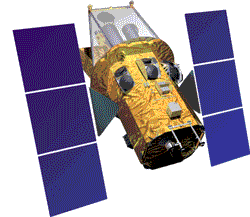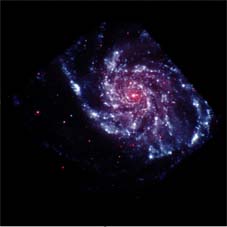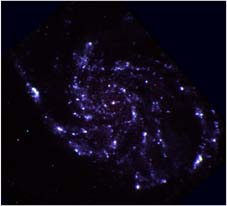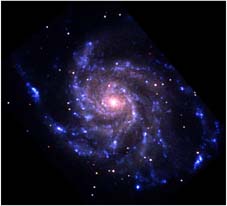 |
 |
||
| • | first-light uvot images | |
| • | swift mission | |
| • | uvot instrument | |
| • | uvot home | |
| • | current status | |
| • | swift team | |
| • | swift links | |
| • | mssl home | |
FIRST-LIGHT IMAGES FROM SWIFT UVOT The Pinwheel Galaxy [M101] is a bright, face-on, spiral galaxy located in the constellation Ursa Major (containing the Plough, or Big Dipper), about 15 million light years from Earth. The UVOT image was taken through a number of filters each sensitive to light of a different colour, ranging from ultraviolet light beyond the range of human eyesight through the blue to yellow portion of the visible spectrum. It is a 'false-colour' image with the shortest wavelength ultraviolet rays being represented as blue, and the longest wavelengths as red. The image shows that hot young stars are being formed in abundance in M101, especially in the spiral arms of the galaxy, where they show up in ultraviolet light. The central regions of the galaxy have cooler, old stars, which appear 'red' in the picture. A number of foreground stars, located in our own Galaxy, also reveal themselves by their red colour. This image demonstrates how the UVOT will provide early ultraviolet and optical data on gamma-ray bursts. Currently no data is available in the UV on the early light curve of these bursts, and there is limited data on the early optical light curve. • Click here for a location map
Combined Ultraviolet-Optical Image (m101_combined.jpg) This UVOT image combines both ultraviolet and visible light from a number of filters. Each filter is sensitive to light of a different colour, ranging from ultraviolet light beyond the range of human eyesight through the blue to yellow portion of the visible spectrum. This is a false-colour image with the shortest wavelength ultraviolet rays being represented as blue, and the longest visible light wavelengths as red. The image shows that hot young stars are being formed in abundance in M101, especially in the spiral arms of the galaxy, where they show up in ultraviolet light. The central regions of the galaxy have more cool, old stars, which appear red in the picture. A number of foreground stars, located in our own Galaxy, also reveal themselves by their red colour. Download image here:
Ultraviolet image (m101_uv.jpg) This UVOT image of the pinwheel galaxy M101 is a 'false-colour' image generated with the UVOT ultraviolet filters. Light from the shortest wavelength ultraviolet filter is represented by blue, with light from the next two shortest wavelength ultraviolet filters being represented by green and red, respectively. This image highlights the star forming regions in the spiral arms, where hot young stars are emitting mostly ultraviolet light. Download image here:
Visible light image (m101_op.jpg) This UVOT image of the pinwheel galaxy M101 is a 'false-colour' image generated with the near-UV, the blue, and yellow filters, represented by blue, green, and red, respectively. This image shows more light from the central regions of the galaxy, where older, cooler stars dominate the emission. Download image here:
Read the full Press Release
|
| Last update was February 2, 2005 16:16 | Maintained by Martin de la Nougerede |


